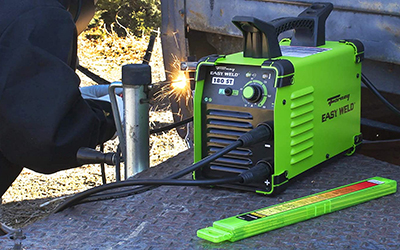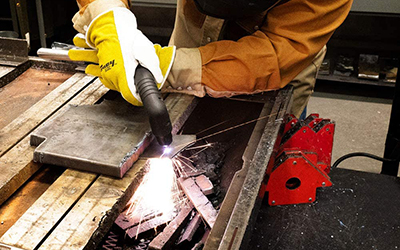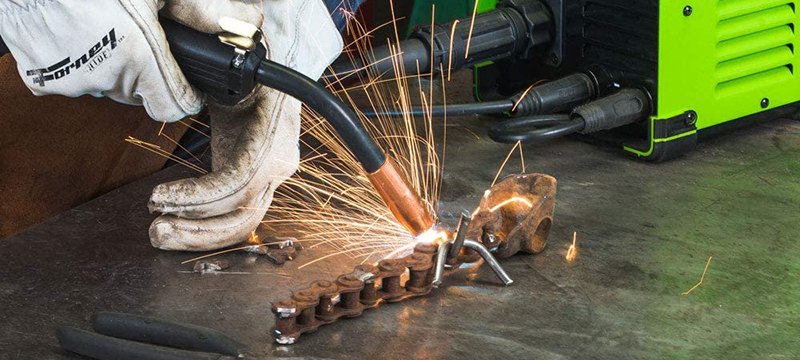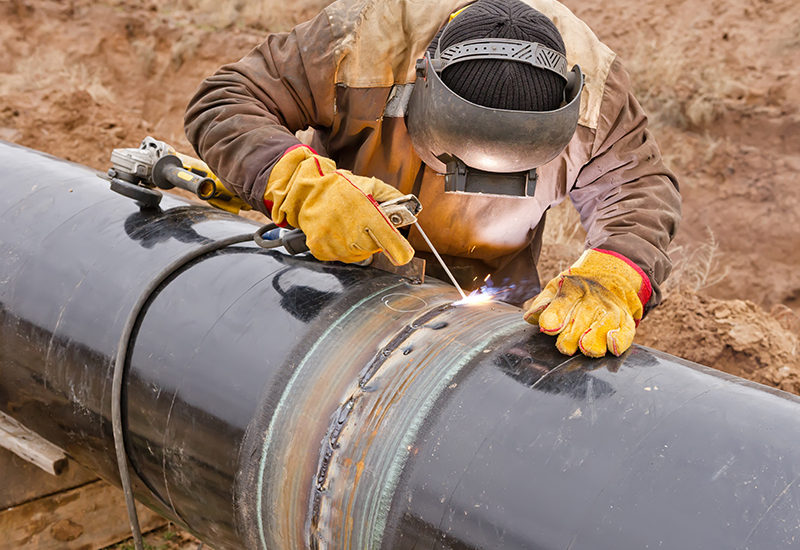
From metal art and DIY projects to automotive fabrication and construction, many consider welding an essential skill. Without welding and metalworking, so many things we know and use in the world today would not exist.
If you’re reading this blog, it probably means you’re interested in practicing this essential skill. It’s time to get excited … your welding journey begins now.
Let’s start with the basics! Welding requires a certain amount of protection. Check out the list below to see what you need to stay safe:
WELDING SAFETY
Auto-Darkening Welding Helmet

Auto-darkening welding helmets have become increasingly efficient in recent years, eliminating the worry of flipping your lens up and down between welds. The auto-darkening filter lens and sensor will activate once an arc is struck, allowing you to clearly see what you’re doing while protecting your eyes from the hazards of arc flash. Forney offers an excellent welding helmet for beginners, the Forney Easy Weld ADF Welding Helmet. The helmet comes in two styles, Black Matte and Velocity: both of which are lightweight, easy to use, and perfect for beginners.
Welding Gloves
Welding gloves are crucial when welding. They can protect you from electrical shock, burns, and radiation while providing abrasion resistance and enhanced grip. Forney offers several great options for welding gloves. The Multi-Purpose Welding Gloves and Signature Welding Gloves will provide protection, strength, and stability while keeping you protected.
Safety Glasses
Safety glasses are recommended under your welding hood for additional protection from flying arc and are also recommended while using abrasives like cutting and grinding discs. Plasma cutting doesn’t initiate an arc, so an ADF welding helmet is not required when using this process. However, safety glasses are crucial to protect your eyes from sparks and flying debris.
Welding Jacket and Fire-Resistant Clothing
Welding jackets are imperative to the welding process. Like the helmet and gloves, welding jackets will protect you from the various welding hazards. In addition to a welding jacket, you should always wear fire-resistant clothing. We suggest 100% cotton shirts, denim jeans, and leather closed-toe shoes.
Safe Welding Environment
Ensuring that you’re in a safe welding environment is crucial as unsafe conditions can result in serious injury or even death. A safe welding environment consists of the following;
- A well-ventilated space
- Free of flammable or hazardous material
- Free of clutter
- Emergency exits in addition to fire alarms, fire extinguishers, sand buckets, or other equipment you would need in the event of a fire
CHOOSING YOUR PROCESS
There are multiple metalworking processes, and it’s important to know the benefits of each before starting a new project. The process you choose can determine the appearance of the weld, the strength of the weld, and the type of metal you’re working on.
MIG Welding (GMAW)

MIG (Metal Inert Gas) welding is a process that uses a continuous solid wire electrode that is heated and fed into a weld pool (a pool of molten metal) from a MIG gun, alongside shielding gas to protect the bond from contaminants in the air. These materials melt together to make a strong bond, alternatively called a joint.
MIG welding is clean, relatively easy, and can be used on thin or thick metals. It works best with carbon steel, stainless steel, and aluminum.
What you’ll need:
- Shielding Gas MIG welding wire
- Contact Tips and Nozzles
- Nozzle Gel
- MIG Pliers
- C-Clamps or Magnets
Flux-Core Wire Welding (FCAW)
Similar to MIG welding, flux-cored arc welding (FCAW) is a wire-feed process; however, it does not require shielding gas. Instead, flux-cored wire shields the arc from contamination.
What you’ll need:
- Wire brush
- Contact tips
- Anti-spatter
- MIG pliers
- Chipping hammer
Stick Welding (SMAW)
Stick (Shielded Metal Arc Welding) is a manual arc welding process that uses consumable electrodes covered with a flux to lay beads. An electric current creates an arc between the electrode and metal. The metal and electrode melt together, forming a weld pool that cools to form a joint. Both elements protect the weld area from atmospheric contamination. Stick welding is mainly used to weld iron and steels (including stainless steel), but you can also weld aluminum, nickel, and copper alloys with specific electrodes. It is simple and versatile, which makes it very popular among metalworkers!
What you’ll need:
- Stick electrodes
- Wire brush
- Contact tips
- Anti-spatter
- MIG pliers
- Chipping hammer
TIG Welding (GTAW)
TIG welding (Gas Tungsten Arc Welding) is one of the more complicated welding processes because it requires the use of inert shielding gas and uses a non-consumable tungsten electrode to weld materials. TIG welding is most commonly used to weld thin sections of stainless steel, aluminum, magnesium, and copper alloys. Although more difficult, TIG welding allows greater control over the weld than the processes listed above, in addition to producing stronger, higher-quality welds. Before learning to TIG weld, one thing to note is understanding that it is significantly slower because instead of automatic wire feeding (like in MIG welding), you feed the wire by hand; however, this process also makes welds more aesthetically pleasing.
What you’ll need:
- Shielding gas
- Tungsten
- Filler metal
- MIG pliers
- Light pair of leather gloves
- Tungsten sharpener/ bench grinder
- Brushes to prep material
Plasma Cutting

Instead of joining metals together, Plasma cutting is a process that allows metals to be cut through electrically with an accelerated jet of hot plasma with a plasma torch. Plasma cutting is typically used on steel, stainless steel, aluminum, brass, copper, and more.
What you’ll need:
- Dark glasses
- Air compressor
- Electrodes
- Cutting tips
- MIG pliers
- Air hose
CHOOSING YOUR MACHINE
Now that your safety is prioritized and you’ve chosen your process (or processes), it’s time to decide the best machine for your needs. Will your machine be used for more DIY projects? Home repair? Maybe both! The Forney Easy Weld line offers an excellent line of machines perfect for any novice welders and their needs. All Forney Easy Weld machines are single-phase, generator friendly, and can run off standard household power!
Forney Easy Weld 100 Stick/TIG Welder (298F)
The Forney Easy Weld 100 ST is a stick and TIG capable welder that is perfect for any novice metalworker, especially those just learning how to weld. This welder is lightweight, weighing only 10 lbs.
Forney Easy Weld 180 Stick/TIG Welder (291F)
The Forney Easy Weld 180 ST is lightweight, easy to use, features dual-voltage, and is generator friendly. This machine is great for do-it-yourself projects, maintenance & repair, metal art, and more! Like the rest of the machines in the Forney Easy Weld line, this unit is perfect for beginners.
Forney Easy Weld 140 Multi-Process Welder (271F)
Are you looking for a machine capable of MIG, TIG, and Stick welding? Look no further than the Forney Easy Weld 140 MP. One of the most popular machines in the line, the Forney Easy Weld 140 MP is ideal for DIY projects, maintenance & repair, metal fabrication, and more.
Forney Easy Weld 140 FC-i MIG welder (261F)
The Forney Easy Weld 140 FC-i is a powerful and lightweight flux-core wire welder. This machine is ideal for do-it-yourselfers, maintenance, repair, metal fabrication, and hobbyists. The Forney Easy Weld 140 FC-i is incredibly convenient, as it does not require gas and can run off standard household power as long as you have at least a 20 AMP breaker.
Forney Easy Weld 20 P Plasma Cutter (251)
The Forney Easy Weld 20 P is a powerful and easy-to-use plasma cutter. Weighing only 21.5 lbs., this unit makes cutting on the go easy and efficient. The convenience doesn’t stop there. This plasma cutter is generator friendly and runs off a standard 120V outlet. Ideal for sheet metal to thin plate cutting, auto body, farm & ranch, HVAC, plumbing, contractor, metal art, and do-it-yourself projects.
A WORD FROM FORNEY’S DIRECTOR OF ENGINEERING AND TECHNICAL SERVICE
“Arc welding may seem intimidating with the sparks and arcs, but it can be a fun hobby and skill to have. Most people can learn the basics of Plasma cutting in 10 minutes, MIG welding in 30 minutes, and Stick welding in about an hour. Getting started welding is fairly easy and fun, but true welding mastery will take a lifetime. When starting welding, adjust your helmet lens settings so you can see the weld puddle and focus on the puddle rather than the arc. It’s very similar to caulking, but with welding, you need to monitor the puddle (manipulate with the arc), the stickout (distance from the electrode to the workpiece), and travel speed, and this will get you started. Learn to read your weld as it will tell you what you are doing, right or wrong.”
– Jason Mahugh, Director- Engineering & Technical Services
Forney Industries
“Now get out there, and start welding!”
– Rachel Bigum, Marketing Generalist
Forney Industries
ADDITIONAL RESOURCES
Why Welding is an Important Industry
How Do Auto-Darkening Helmets Work
Creating a Safe Welding Environment
Welding Safety Tips and Guidelines for 2020
– This blog post was created by Forney Industries in partnership with Acme Tools. Check out more Forney Industries’ products on their website.




